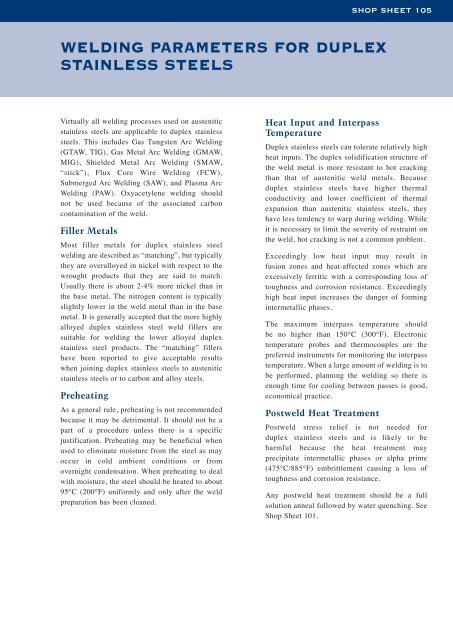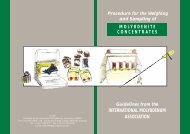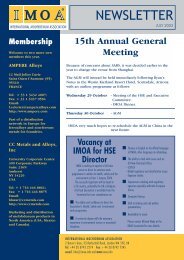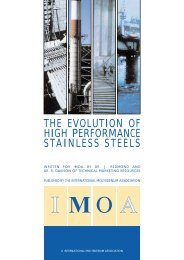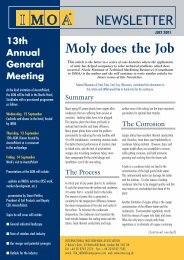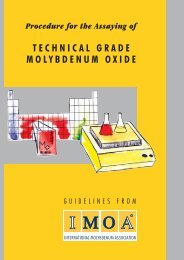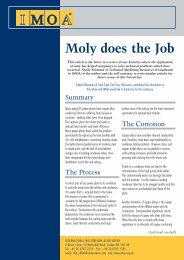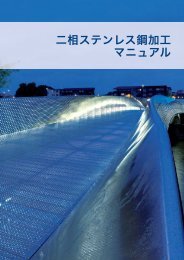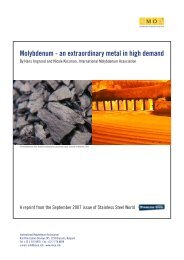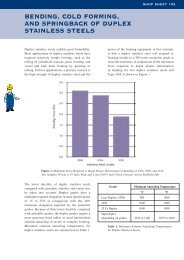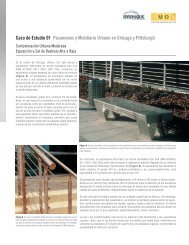105: Welding parameters for duplex stainless steels - IMOA
105: Welding parameters for duplex stainless steels - IMOA
105: Welding parameters for duplex stainless steels - IMOA
You also want an ePaper? Increase the reach of your titles
YUMPU automatically turns print PDFs into web optimized ePapers that Google loves.
SHOP SHEET <strong>105</strong><br />
WELDING PARAMETERS FOR DUPLEX<br />
STAINLESS STEELS<br />
Virtually all welding processes used on austenitic<br />
<strong>stainless</strong> <strong>steels</strong> are applicable to <strong>duplex</strong> <strong>stainless</strong><br />
<strong>steels</strong>. This includes Gas Tungsten Arc <strong>Welding</strong><br />
(GTAW, TIG), Gas Metal Arc <strong>Welding</strong> (GMAW,<br />
MIG), Shielded Metal Arc <strong>Welding</strong> (SMAW,<br />
“stick”), Flux Core Wire <strong>Welding</strong> (FCW),<br />
Submerged Arc <strong>Welding</strong> (SAW), and Plasma Arc<br />
<strong>Welding</strong> (PAW). Oxyacetylene welding should<br />
not be used because of the associated carbon<br />
contamination of the weld.<br />
Filler Metals<br />
Most filler metals <strong>for</strong> <strong>duplex</strong> <strong>stainless</strong> steel<br />
welding are described as “matching”, but typically<br />
they are overalloyed in nickel with respect to the<br />
wrought products that they are said to match.<br />
Usually there is about 2-4% more nickel than in<br />
the base metal. The nitrogen content is typically<br />
slightly lower in the weld metal than in the base<br />
metal. It is generally accepted that the more highly<br />
alloyed <strong>duplex</strong> <strong>stainless</strong> steel weld fillers are<br />
suitable <strong>for</strong> welding the lower alloyed <strong>duplex</strong><br />
<strong>stainless</strong> steel products. The “matching” fillers<br />
have been reported to give acceptable results<br />
when joining <strong>duplex</strong> <strong>stainless</strong> <strong>steels</strong> to austenitic<br />
<strong>stainless</strong> <strong>steels</strong> or to carbon and alloy <strong>steels</strong>.<br />
Preheating<br />
As a general rule, preheating is not recommended<br />
because it may be detrimental. It should not be a<br />
part of a procedure unless there is a specific<br />
justification. Preheating may be beneficial when<br />
used to eliminate moisture from the steel as may<br />
occur in cold ambient conditions or from<br />
overnight condensation. When preheating to deal<br />
with moisture, the steel should be heated to about<br />
95°C (200°F) uni<strong>for</strong>mly and only after the weld<br />
preparation has been cleaned.<br />
Heat Input and Interpass<br />
Temperature<br />
Duplex <strong>stainless</strong> <strong>steels</strong> can tolerate relatively high<br />
heat inputs. The <strong>duplex</strong> solidification structure of<br />
the weld metal is more resistant to hot cracking<br />
than that of austenitic weld metals. Because<br />
<strong>duplex</strong> <strong>stainless</strong> <strong>steels</strong> have higher thermal<br />
conductivity and lower coefficient of thermal<br />
expansion than austenitic <strong>stainless</strong> <strong>steels</strong>, they<br />
have less tendency to warp during welding. While<br />
it is necessary to limit the severity of restraint on<br />
the weld, hot cracking is not a common problem.<br />
Exceedingly low heat input may result in<br />
fusion zones and heat-affected zones which are<br />
excessively ferritic with a corresponding loss of<br />
toughness and corrosion resistance. Exceedingly<br />
high heat input increases the danger of <strong>for</strong>ming<br />
intermetallic phases.<br />
The maximum interpass temperature should<br />
be no higher than 150°C (300°F). Electronic<br />
temperature probes and thermocouples are the<br />
preferred instruments <strong>for</strong> monitoring the interpass<br />
temperature. When a large amount of welding is to<br />
be per<strong>for</strong>med, planning the welding so there is<br />
enough time <strong>for</strong> cooling between passes is good,<br />
economical practice.<br />
Postweld Heat Treatment<br />
Postweld stress relief is not needed <strong>for</strong><br />
<strong>duplex</strong> <strong>stainless</strong> <strong>steels</strong> and is likely to be<br />
harmful because the heat treatment may<br />
precipitate intermetallic phases or alpha prime<br />
(475°C/885°F) embrittlement causing a loss of<br />
toughness and corrosion resistance.<br />
Any postweld heat treatment should be a full<br />
solution anneal followed by water quenching. See<br />
Shop Sheet 101.
SHOP SHEET <strong>105</strong><br />
Short-Circuiting Arc Transfer<br />
Spray Arc Transfer<br />
Weld Wire Diameter Current Voltage<br />
mm inch (amps) (volts)<br />
1.0 0.035 90-120 19-21<br />
1.2 0.045 110-140 20-22<br />
1.0 0.035 170-200 26<br />
1.2 0.045 210-280 29<br />
1.6 0.063 270-330 30<br />
Table 1. Typical Gas-Metal Arc <strong>Welding</strong> (GMAW) Parameters <strong>for</strong> Short-Circuiting Arc Transfer and <strong>for</strong> Spray Arc Transfer<br />
<strong>for</strong> <strong>Welding</strong> Duplex Stainless Steels with Various Wire Sizes (Source: Avesta Sheffield AB)<br />
Electrode Diameter Current Voltage<br />
mm inch ampere volt<br />
2.0 0.078 35-60 22-28<br />
2.5 0.094 60-80 22-28<br />
3.25 0.125 80-120 22-28<br />
4.0 0.156 100-160 22-28<br />
Table 2. Typical Shield-Metal Arc <strong>Welding</strong> (SMAW) Parameters <strong>for</strong> <strong>Welding</strong> Duplex Stainless Steels with Various Size<br />
Electrodes (Source: Avesta Sheffield AB)<br />
Electrode Diameter Current Voltage<br />
mm inch ampere volt<br />
2.5 0.094 250-450 28-32<br />
3.25 0.125 300-500 29-34<br />
4.0 0.156 400-600 30-35<br />
5.0 0.203 500-700 30-35<br />
Table 3. Typical Submerged Arc <strong>Welding</strong> (SAW) Parameters <strong>for</strong> <strong>Welding</strong> Duplex Stainless Steels with Various Size Wire<br />
(Source: Avesta Sheffield AB)<br />
Excepted from “Practical Guidelines <strong>for</strong> the Fabrication of Duplex Stainless Steels”.<br />
©1999 International Molybdenum Association<br />
Printed by BSC Print Ltd, BSC House, 48 Weir Road, London SW19 8UG.<br />
<strong>IMOA</strong>-15


